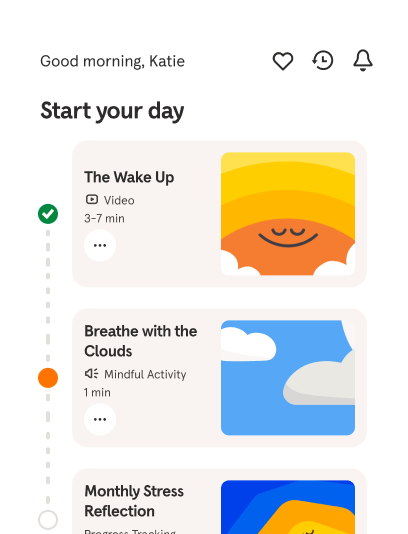Itching
Instead of reacting to an itch by scratching it, learn to watch it and allow it to pass.
Try 14 days freeBetter mental health starts with Headspace. Unrivaled expertise to make life feel a little easier, using guided meditations, mindfulness tips, focus tools, sleep support, and dedicated programs.
Try 14 days free
If you've sat getting some Headspace often enough, then for sure at some stage or another, you'll have experienced that feeling of itching. Often it's on the head, but it can be anywhere on the body. And as we sit there trying to focus our attention on a particular object, whether that's internal or external, it can be really difficult to resist the temptation to scratch, of course, we think that we have to maintain that posture and not move in any way. And of course, the more we focus on that as an idea, okay, I can't move, I can't move, I can't move, usually the more intense the feeling of itching becomes. Until eventually we feel like, "I just can't cope with it anymore, I'm gonna scratch it." But there's a different way of approaching it. And, it's really about kind of watching the sensation. So, momentarily, when you feel that sensation of itching, where it becomes so apparent that you can no longer really focus on the object, the technique itself, simply forget about the technique for a moment and bring your full attention to that sensation of itching. That is now your new object to focus on. And you're not thinking about it, it's not, "Oh that really itches. Oh, can I scratch it? Am I allowed to scratch it? Oh, I'm gonna have to move soon." That's thinking about the feeling, that's not being present with the feeling. Instead we're just aware of the sensation. And as you really start to watch the sensation, you notice that actually it's not something kind of fixed. Beforehand we might have said, okay it's, yeah, it's just, I don't know, it's just an annoyance. It's an irritant in that particular place. But then as we watch it, maybe it stays still for a little while, then it moves, and it's often not in as the saying just one place. It's often the sensation of kind of movement from one place to the next very, very quickly. Sometimes it's there sometimes it's not. So as soon as we watch that, it starts to kind of loosen up because we can't say it's something permanent and fixed because sometimes it's there, sometimes it's not, and it's always changing in its intensity and frequency. So through doing that we start to become a little more responsive and a little less reactive. It essentially becomes a training for our life. So something happens. The temptation, our habit, our conditioning is to reach out and do something immediately, essentially to react. And in reacting, although we might remove the problem for a moment, we don't really understand the problem. So as soon as we remove the itch we no longer have the opportunity to examine that urge, that tendency to move it, to move away from the annoyance. But if we can sit with it for long enough, then instead we kind of cultivate this ability to watch, examine, be interested, curious, essentially...
Details
About your teachers
 Andy PuddicomeHeadspace Co-founderMore about Andy
Andy PuddicomeHeadspace Co-founderMore about AndyA former Buddhist monk, Andy has guided people in meditation and mindfulness for 20 years. In his mission to make these practices accessible to all, he co-created the Headspace app in 2010.
 Eve Lewis PrietoHeadspace Director of MeditationMore about Eve
Eve Lewis PrietoHeadspace Director of MeditationMore about EveEve is a mindfulness teacher, overseeing Headspace’s meditation curriculum. She is passionate about sharing meditation to help others feel less stressed and experience more compassion in their lives.
 Dora KamauMeditation TeacherMore about Dora
Dora KamauMeditation TeacherMore about DoraAs a meditation teacher, Dora encourages others to live, breathe, and be with the fullness of their experiences. She loves meditation’s power to create community and bring clarity to people’s minds.
 Kessonga GiscombeMeditation TeacherMore about Kessonga
Kessonga GiscombeMeditation TeacherMore about KessongaKessonga has been an acupuncturists, therapist, and meditation teacher, working to bring mindfulness to the diverse populations of the world.
 Rosie AcostaMeditation TeacherMore about Rosie
Rosie AcostaMeditation TeacherMore about RosieRosie Acosta has studied yoga and mindfulness for more than 20 years and taught for over a decade. Rosie’s mission is to help others overcome adversity and experience radical love.

Your lifelong guide to better mental health
Stress, sleep, and all the challenging emotions — care for your mind with the everyday mental health app that's shown to make a difference.
Try 14 days free
Look after your mind
Proven guided meditations and programs to help you stress less, sleep more soundly, and better navigate life’s challenges

Science-backed
Studies show that using Headspace for 30 days can reduce stress, increase resilience, and improve overall well-being

Explore 1000+ expert-led exercises
Access our library of meditations, breathing exercises, and guidance videos for stress, sleep, focus, everyday anxiety , parenting, and more.




Members are enjoying happier and healthier lives
Related to 'Itching'
- © 2025 Headspace Inc.
- Terms & conditions
- Privacy policy
- Consumer Health Data
- Your privacy choices
- CA Privacy Notice


